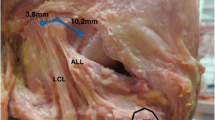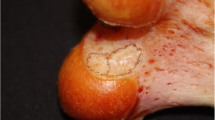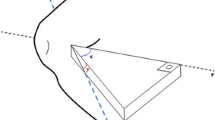Abstract
Purpose
Some studies have investigated knee flexion angle on the sagittal plane and insertion angle of the cross-pin on the coronal plane to evaluate proper femoral fixation. They evaluated the possibilities of injury to the posterolateral (PL) and neurovascular structures using several methods. The purposes of this study were to evaluate (1) the influence of knee flexion and femoral cross-pin insertion angles on knee PL structures and (2) the lateral fixation length of the cross-pin.
Methods
Ten fresh cadaveric knees with no previous surgeries around the knee were used. Transtibial femoral tunnels (1:30 or 10:30 o’clock position) were made at three different knee flexion angles (70°, 90°, and 110°). Two cross-pin guidewires (superior and inferior pins) were drilled at three different insertion angles [downward 30°, 0° (parallel to floor line), and upward 30°] for each knee flexion position. The distances from the insertion point of the two cross-pins to the lateral collateral ligament (LCL) and popliteus tendon (PT), and the distance from the lateral wall of the femoral tunnel to the lateral cortex of the femoral condyle were measured.
Results
No significant differences were observed in the superior and inferior pin depths (p = 0.56 and 0.39). The distances from the superior pin to the LCL and from the inferior pin to the LCL were significantly shorter in all knee flexions with 0° and an upward 30° insertion angle than with 70° and 90° knee flexion with a downward 30° insertion angle, respectively (superior pin: p = 0.02 and 0.03; inferior pin: p = 0.03 and 0.03). No significant difference was observed in the distance between the superior pin and inferior pins and the PT (p = 0.25).
Conclusions
The cross-pin was inserted close to the LCL and PT, and a downward 30° angle was the safest insertion angle. Lateral fixation length was sufficient for the cross-pin fixation in the 10:30- or 1:30-positioned femoral tunnel.


Similar content being viewed by others
References
Ahn JH, Park JS, Lee YS, Cho YJ (2007) Femoral bioabsorbable cross-pin fixation in anterior cruciate ligament reconstruction. Arthroscopy 23:1093–1099
Basdekis G, Abisafi C, Christel P (2008) Influence of knee flexion angle on femoral tunnel characteristics when drilled through the anteromedial portal during anterior cruciate ligament reconstruction. Arthroscopy 24:459–464
Castoldi F, Bonasia DE, Marmotti A, Dettoni F, Rossi R (2008) ACL reconstruction using the Rigidfix femoral fixation device via the anteromedial portal: a cadaver study to evaluate chondral injuries. Knee Surg Sports Traumatol Arthrosc 16:275–278
Chang CB, Yoo JH, Chung BJ, Seong SC, Kim TK (2010) Oblique femoral tunnel placement can increase risks of short femoral tunnel and cross-pin protrusion in anterior cruciate ligament reconstruction. Am J Sports Med 38:1237–1245
Chen NC, Boykin RE, Millett PJ (2007) Broken femoral cross-pin after hamstring anterior cruciate ligament reconstruction: case report. J Knee Surg 20:245–248
Choi NH, Lee JH, Victoroff BN (2007) Do broken cross-pins compromise stability after anterior cruciate ligament reconstructions with hamstring tendons? Arthroscopy 23:1334–1340
Cossey AJ, Paterson RS (2005) Loose intra-articular body following anterior cruciate ligament reconstruction. Arthroscopy 21:348–350
Han I, Kim YH, Yoo JH, Seong SC, Kim TK (2005) Broken bioabsorbable femoral cross-pin after anterior cruciate ligament reconstruction with hamstring tendon graft: a case report. Am J Sports Med 33:1742–1745
Hoshino Y, Nagamune K, Yagi M et al (2009) The effect of intra-operative knee flexion angle on determination of graft location in the anatomic double-bundle anterior cruciate ligament reconstruction. Knee Surg Sports Traumatol Arthrosc 17:1052–1060
Jung YB, Nam CH, Jung HJ, Lee YS, Ko YB (2009) The influence of tibial positioning on the diagnostic accuracy of combined posterior cruciate ligament and posterolateral rotatory instability of the knee. Clin Orthop Surg 1:68–73
McKeon BP, Gordon M, DeConciliis G, Scheller A (2007) The safe zone for femoral cross-pin fixation: an anatomical study. J Knee Surg 20:285–288
Nishimoto K, Kuroda R, Mizuno K et al (2009) Analysis of the graft bending angle at the femoral tunnel aperture in anatomic double bundle anterior cruciate ligament reconstruction: a comparison of the transtibial and the far anteromedial portal technique. Knee Surg Sports Traumatol Arthrosc 17:270–276
Pujol N, David T, Bauer T, Hardy P (2006) Transverse femoral fixation in anterior cruciate ligament (ACL) reconstruction with hamstrings grafts: an anatomic study about the relationships between the transcondylar device and the posterolateral structures of the knee. Knee Surg Sports Traumatol Arthrosc 14:724–729
Yan J, Sasaki W, Hitomi J (2010) Anatomical study of the lateral collateral ligament and its circumference structures in the human knee joint. Surg Radiol Anat 32:99–106
Conflict of interest
We declare that we have no conflict of interest.
Author information
Authors and Affiliations
Corresponding author
Rights and permissions
About this article
Cite this article
Kim, J.G., Lee, Y.S., Ha, J.K. et al. Influence of knee flexion and femoral cross-pin insertion angle on posterolateral structures of the knee and lateral fixation lengths during ACL reconstruction. Surg Radiol Anat 34, 421–425 (2012). https://doi.org/10.1007/s00276-011-0922-7
Received:
Accepted:
Published:
Issue Date:
DOI: https://doi.org/10.1007/s00276-011-0922-7




